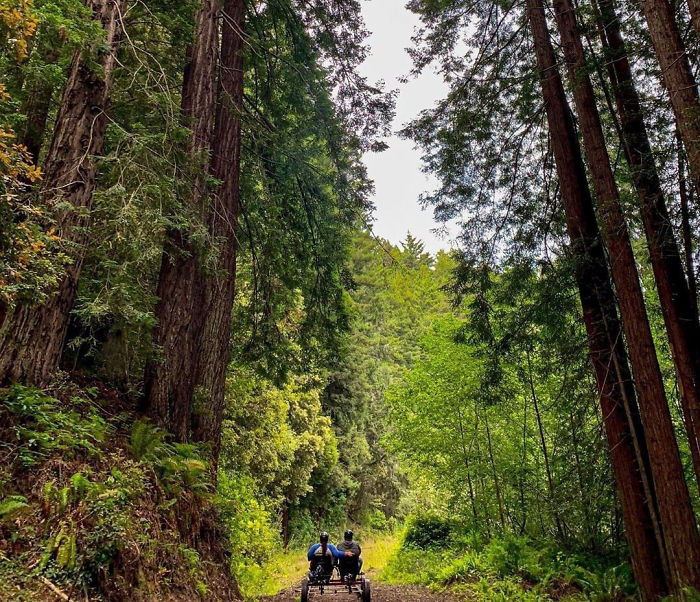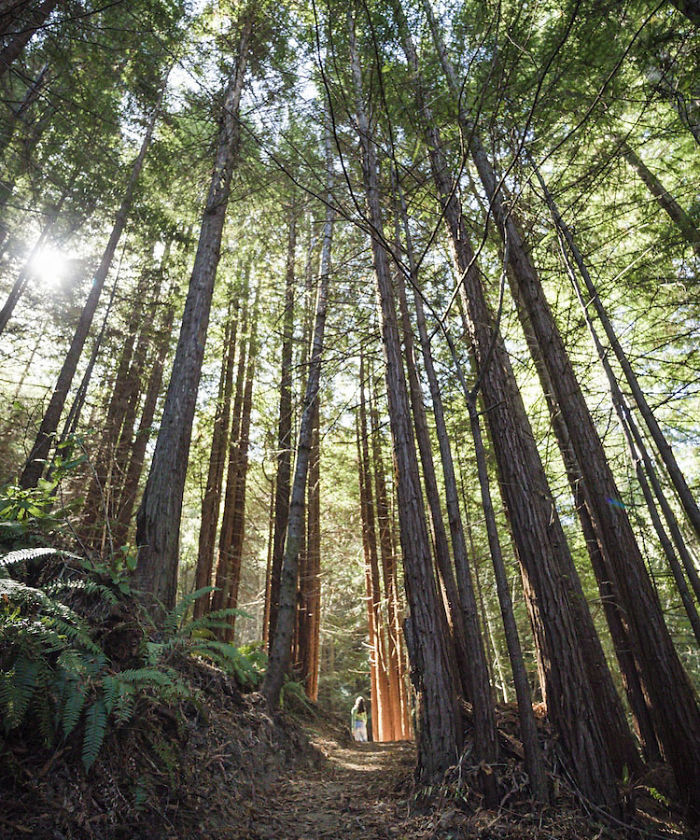In the early 1880s, lumbermen C.R. Johnson, Calvin Stewart, and James Hunter joined forces to expand timber operations in Mendocino County, California. By 1885, the Fort Bragg Railroad was formed in an attempt to make transporting lumber easier. Essentially, this was the foundation of what would one day become the California Western Railroad, more commonly known as The Skunk.
The Skunk got the nickname in 1925 when motorcars were introduced (today sometimes referred to as railbuses or railcruisers). These self-propelled motorcars had gasoline-powered engines for power and pot-bellied stoves burning crude oil to keep the passengers warm. The combination of the fumes created a very distinct odor, and the old-timers living along the line said these motorcars were like skunks, “You could smell them before you could see them.”
More info: skunktrain.com | Facebook | Instagram | vimeo

Image credits: skunktrain
Initially, California Western Railroad was operated as a division of the Fort Bragg mill (Union Lumber Company, Boise-Cascade). In the mid-1960s, however, Arizona-based Kyle Railways began managing the railroad and purchased it in 1987.
In August 1996, a group of local Mendocino Coast investors bought California Western, marking the first time in its 111-year history that the line would operate as an independent business.

Image credits: skunktrain
People can enjoy the historical tracks in quite a few different ways, from sharing their cookies with Santa Claus aboard the Magical Christmas Train throughout December to celebrating fall by hopping onto the Pumpkin Express. But recently, a Fort Bragg excursion on railbikes has become more and more popular. After seeing the photos, it becomes quite clear why.

Image credits: skunktrain
The custom-built electric railbikes are virtually silent and fit two people. Peddling along the historic tracks, groups wend their way along scenic Pudding Creek, cross over majestic wooden trestle bridges, and journey into the heart of the ancient redwoods of Mendocino County.
“The Redwood forest is a dreamlike place, particularly on a rainy or misty day, it’s like a scene from Jurassic Park,” Robert Jason Pinoli, “The Chief Skunk”, told Bored Panda. “With the railbikes traveling along the Pudding Creek Estuary, you can’t help but think that a brontosaurus might be around the next corner.”

Image credits: skunktrain
Pinoli highlighted that redwoods only grows naturally in one small slice of the world, from Big Sur to the California-Oregon border, and only about 12 air miles inland. “These trees are hundreds of feet tall and are each a unique monument to the very forest they make up. The tracks of the Skunk Train date back to 1885 and trains have been running over them continuously for 135 years.”

Image credits: skunktrain
Without needing to steer, people are unbound and able to look around all the wonders of the natural world. “Common sittings are otters, egrets, a lounging turtle, deer, and on the early morning trip an occasional bear too,” Pinoli explained.

Image credits: skunktrain
The rate is $250.00 per bike, and includes the 8% Historic Preservation Assessment.
At first, the company thought of the railbikes as a way to entice more millennials to come to experience the route of the Skunk Train, but quickly found out that folks who are older were also drawn to the trip because the bikes allow people with mobility to complete the journey without much fuss as well.

Image credits: skunktrain

Image credits: skunktrain

Image credits: skunktrain

Image credits: skunktrain

Image credits: skunktrain

Image credits: skunktrain

Image credits: skunktrain

Image credits: skunktrain

Image credits: skunktrain

Image credits: skunktrain

Image credits: skunktrain

Image credits: skunktrain
Here’s what people have been saying about the trip so far





from Bored Panda https://bit.ly/2DikRfM
via Boredpanda
